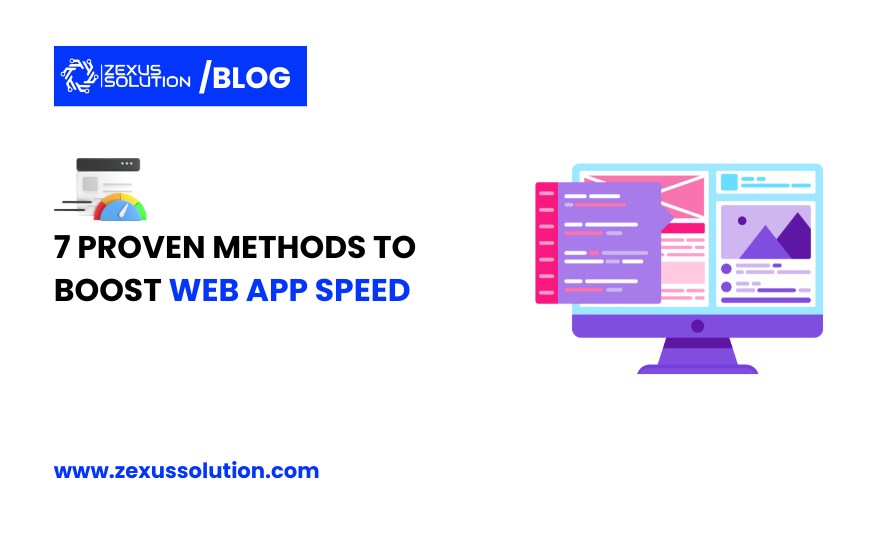Table of Contents
Are you tired of your website’s poor performance? Slow loading times reduce the number of visitors and affect your search engines. In today’s fast-paced world, the user wants instant gratification, and web app speed plays a key role in delivering that experience. A slow web app can frustrate users, higher bounce rates, and lead to loss of business.
Potential clients are probably only going to spend a few seconds on your website due to the growing competition. They will eventually arrive at the rival website after that. For this reason, your website needs to load quickly and operate well to keep users interested and turn them into buyers.
Here, we delve into seven proven methods to boost web app speed, ensuring your users enjoy a seamless and efficient experience.
7 Methods To Boost Web App Speed
Image Optimization

One way to improve web app speed is to make pictures load quickly. Although they play a vital role in online design, images can considerably impede page loading speed. You can lessen this by ensuring that your photos are appropriately compressed without sacrificing quality.
Use more recent picture formats, such as WebP, which provide superior compression without sacrificing image quality. Furthermore, activates lazy loading, a feature that saves important loading time by delaying the loading of images until they start to show on the user’s screen. By optimizing your images and media files, you can significantly enhance your web app speed.
Minify and Bundle CSS and JavaScript
CSS and JavaScript files are essential for the functionality and appearance of modern web apps, but they can also be a significant drag on performance if not managed properly. Minifying and bundling these files can substantially improve web app speed.
Remove unnecessary characters, such as whitespaces and comments, from your CSS and JavaScript files to reduce their size. Tools like UglifyJS and CSSNano can automate this process. Combine multiple CSS and JavaScript files into a single file to reduce the number of HTTP requests. Webpack is a popular tool for this task.
Make Use of Browser Caching.
Utilize browser caching to speed uploads. With the help of a potent technique called browser caching, users can save frequently used website resources like photos, style sheets, and scripts locally on their devices. This makes it possible for subsequent visits to load faster.
You can guarantee that users get the most recent versions of resources when they need them by establishing deadlines for certain kinds of material. This lowers bandwidth usage and server load in addition to speeding up downloads. By enabling browser caching, you can significantly improve your web app speed, especially for returning users.
Implement Content Delivery Networks (CDNs)

A Content Delivery Network (CDN) is a system of distributed servers that deliver web content to users based on their geographic location. By using a CDN, you can significantly reduce the latency and improve the web app speed.
CDNs have servers located around the world, ensuring that users receive content from a server that is geographically closest to them. CDNs distribute traffic across multiple servers, preventing any single server from becoming overwhelmed and slowing down.
Enable Browser Caching
Browser caching allows users’ browsers to store copies of web pages, images, and other resources locally. When users revisit your web app, their browser can load these resources from the cache instead of downloading them again, resulting in faster load times.
Set appropriate Cache-Control headers to specify how long browsers should cache your web app’s resources. Use Expires headers to define the expiry date for certain resources, ensuring that browsers update their cached versions when necessary.
Simplify Navigation

Users may locate and access content on a website by using the navigation feature, which is a part of the design. It could consist of various pages, buttons, links, etc. Although navigation has no direct impact on website speed, it might cause extra page loads and a bad user experience.
By arranging the web pages, you can enhance the website’s navigability. Additionally, make sure that the user can easily see and use the menu, Call To Action (CTA) buttons, and other helpful links.
Additionally, seamless navigation improves the performance of the website by making it simpler for search engines to crawl and index the pages. This is known as Search Engine Optimization.
Eliminate Unwanted Plugins
Several plugins are frequently used by websites housed on content management systems like WordPress to enhance their functionality and feature sets. However, in addition to the functions, they add extra page weight, which slows down your website.
Plugin requirements differ depending on the type of business. However, you may search for and remove undesirable plugins from your website.
For example, think about a plugin for email newsletters. You might think about taking your newsletters off of your website if you don’t send them out regularly.
Conclusion
Enhancing your web app speed is not just about technical optimization; it’s about delivering a superior user experience that keeps visitors engaged and satisfied. By implementing these seven proven methods, you can significantly boost your web app speed.
Web app Maintenance requires continuous effort and regular updates. For long-term success, consider investing in web app maintenance services to keep your web app running smoothly and efficiently. Modern web apps demand a proactive approach to performance optimization, ensuring that you stay ahead in the competitive digital landscape.
Protecting your web app from performance issues is crucial for user satisfaction and business growth. By focusing on these strategies, you can create a fast, responsive, and user-friendly web app that meets the demands of today’s users.



Add a Comment